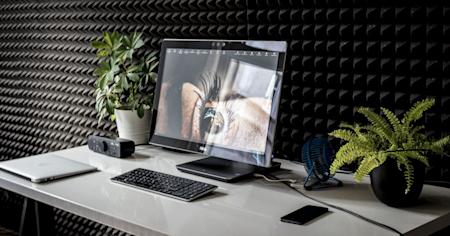遠端桌面是一種技術,可讓使用者透過網路連線,從不同地點存取和控制電腦。它使個人和 IT 團隊能夠遠端工作、提供技術支援和管理系統,而無需實體存取。遠端桌面解決方案可提高生產力、簡化 IT 作業,並確保無縫協作,因此對於企業、教育工作者和遠端工作者而言是不可或缺的。
在遠距工作和全球協作成為新常態的時代,遠端存取和管理電腦的能力不再是一種奢侈品,而是一種必需品。 無論是存取文件、運行應用程式還是提供技術支持,遠端桌面解決方案都提供無與倫比的靈活性和控制力,使其成為各種規模的企業不可或缺的一部分。
遠端桌面的概念並不新鮮,但隨著遠端工作的興起以及對無縫、安全存取資源的需求,其相關性急劇上升。 透過利用遠端桌面技術,企業可以確保其團隊保持高效,無論其實體位置為何。
在本部落格中,我們將探討什麼是遠端桌面技術、它的功能以及它為企業提供的眾多好處。

遠端桌面如何運作?
遠端桌面技術可讓使用者透過安全的網路連線,從另一個地點連接和控制電腦。 從技術層面來看,其工作原理如下:
會話啟動:遠端桌面用戶端傳送連線要求至遠端電腦,通常是透過網際網路或私人網路。
網路通訊: 遠端桌面通訊協定 (例如Splashtop的專屬通訊協定) 會在用戶端和遠端 裝置之間建立加密的連線。
螢幕& 輸入傳輸:遠端電腦的顯示被編碼並傳送至用戶端裝置,而使用者的輸入(滑鼠移動和鍵盤操作)則會即時傳送回來。
資料加密與安全措施: TLS 和 AES 等進階加密協定可保護資料傳輸,以防止未經授權的存取或攔截。
多顯示器& 周邊設備支援:遠端桌面軟體可支援多顯示器顯示、檔案傳輸、剪貼簿共用及週邊裝置存取 (印表機、USB 裝置) 等功能。
透過利用這些技術,Splashtop 等遠端桌面解決方案可為企業、IT 管理員和需要安全、高效遠端連線的專業人員提供低延遲、高效能的遠端存取。
遠端桌面技術對企業的好處
遠端桌面技術已成為現代企業營運不可或缺的一部分,特別是隨著遠距工作和分散式團隊變得越來越普遍。 透過允許員工和 IT 專業人員幾乎從任何地方存取電腦和網絡,遠端桌面技術提供了許多優勢,可以提高組織內的生產力、效率和安全性。
以下是企業從實施遠端桌面解決方案所能獲得的主要效益。
1. 增強靈活性和移動性
遠端桌面技術最顯著的好處之一是能夠透過網路連接從任何位置存取工作站和資源。 這種靈活性對於採用遠端或混合工作模式的企業來說非常寶貴,因為它允許員工在家、出差時或在其他異地地點工作,而不會影響他們對基本工具和資料的存取。
2. 成本節約與資源最佳化
實施遠端桌面技術可以為企業節省大量成本。 例如,公司可以透過允許員工遠距工作來減少對實體辦公空間的需求以及相關的管理費用。 此外,遠端桌面解決方案可透過從較便宜、功能較弱的用戶端裝置存取強大的集中資源,從而延長現有硬體的使用壽命。
此外,企業可以透過集中軟體和硬體管理來簡化 IT 運營,減少現場技術支援和維護的需求。 這種集中式方法可讓 IT 團隊遠端管理、更新系統並排除故障,從而更有效地利用資源並降低 IT 基礎架構的總擁有成本 (TCO)。
3. 提高生產力
遠端桌面技術使員工能夠存取自己的工作站並在辦公室外完成任務,從而在管理工作負載和截止日期方面具有更大的靈活性。 這種增加的存取權限可以提高生產力水平,因為員工可以以最適合他們的日程安排和個人喜好的方式工作。
4. 提高資料安全性和合規性
資料安全是企業的首要任務,遠端桌面技術在保護敏感資訊方面可以發揮關鍵作用。 透過將資料儲存在託管電腦上而不是單一裝置上,企業可以降低因硬體遺失或被盜而導致資料外洩的風險。
5. 可擴展性和易於管理
隨著業務的成長,他們的 IT 需求也在成長。 遠端桌面技術提供了可擴展的解決方案,可輕鬆容納新員工、設備和位置的添加,而無需進行大量基礎設施投資。 這種可擴展性對於快速成長的企業或在多個地區或國家營運的企業特別有利。
6. 業務連續性與災難復原
在當今不可預測的世界中,制定健全的業務連續性計畫至關重要。 遠端桌面技術在災難復原策略中發揮關鍵作用,它確保員工即使無法實際存取其辦公室也可以繼續存取關鍵系統和資料。 無論是自然災害、網路攻擊還是流行病,遠端桌面解決方案都可以使企業以最小的中斷維持營運。
7. 支持 BYOD(自帶裝置)政策
許多企業正在採用BYOD 政策,允許員工使用個人裝置進行工作。 遠端桌面技術支援從任何裝置(無論是個人筆記型電腦、平板電腦或智慧型手機)安全存取公司資源,從而支援這一趨勢。 這不僅允許員工在自己喜歡的設備上工作,從而提高員工滿意度,而且還減少了公司投資昂貴硬體的需求。
遠端桌面的挑戰
雖然遠端桌面軟體可讓您從任何地方無縫存取電腦,但它也帶來了可能影響效能、安全性和可用性的挑戰。 了解這些挑戰凸顯了選擇高品質解決方案的重要性。
效能問題- 延遲、延遲和連線穩定性不佳,都會擾亂工作流程,尤其是在使用低品質或最佳化程度不佳的遠端桌面軟體時。
安全風險-不安全的遠端存取可能會使系統面臨網路威脅,包括未經授權的存取、資料外洩和勒索軟體攻擊。 開啟的 RDP 連接埠和弱認證是常見的漏洞。
相容性限制- 某些遠端桌面解決方案的裝置或作業系統相容性受到限制,因而無法跨平台存取。
複雜的設定與管理- 配置某些遠端桌面工具可能很複雜,需要 IT 專業知識和持續維護。
優質的遠端桌面解決方案 (如Splashtop) 能以高效能串流、企業級安全性、廣泛的裝置相容性及直覺的使用者體驗解決這些挑戰,確保無縫及安全的遠端存取。
遠端桌面的重要功能
在評估遠端桌面解決方案時,考慮滿足您企業特定需求的功能至關重要。 雖然不同的解決方案可能提供各種功能,但某些關鍵功能對於確保安全、高效和用戶友好的遠端桌面體驗至關重要。
1. 高效能遠端存取
任何遠端桌面解決方案最關鍵的功能之一是其提供高效能遠端存取的能力。 這包括即使在存取資源密集型應用程式或高解析度圖形時也能提供流暢、響應靈敏的體驗。
先進的遠端桌面解決方案可優化資料傳輸和壓縮,以最大程度地減少延遲,並確保使用者即使在較慢的連線情況下也能體驗到最小的延遲。 這種高效能對於需要即時互動的任務(例如影片編輯、圖形設計或金融交易)至關重要。
2. 跨平台相容性
在當今多元化的 IT 環境中,企業通常依賴多種作業系統和設備,包括Windows 、 MacOS 、Linux、 Android和 iOS。 強大的遠端桌面解決方案應提供跨平台相容性,允許使用者從單一介面連接和控制運行不同作業系統的裝置。
3. 強大的安全功能
實施遠端桌面技術時,安全性是首要問題,因為未經授權存取業務系統可能會導致資料外洩、財務損失和聲譽受損。 因此,安全的遠端桌面解決方案應包括一系列強大的安全功能,以防範潛在威脅。
需要尋找的關鍵安全功能包括:
端對端加密:確保用戶端和主機設備之間傳輸的所有資料都經過加密,未經授權的各方無法存取。
多重驗證 (MFA) :要求使用者使用第二個因素來驗證其身份,例如除了密碼之外還發送到其行動裝置的代碼,從而增加額外的安全層。
精細的存取控制:允許管理員定義和管理存取權限,確保使用者只能存取他們有權使用的資源。
連線記錄和監控:使 IT 管理員能夠即時監控遠端會話或查看記錄的會話,以偵測可疑活動並確保遵守安全策略。
4. 可擴展性和資源管理
隨著企業的發展,其 IT 需求也在不斷變化,擴展遠端桌面解決方案的能力至關重要。 可擴展的遠端桌面解決方案應該允許企業輕鬆添加新用戶、設備和資源,而無需對基礎設施進行重大更改。
5.使用者友善的介面
遠端桌面解決方案的可用性對於確保員工無需大量培訓或技術支援即可輕鬆存取和管理遠端會話至關重要。 使用者友善的介面應提供直覺的體驗、輕鬆的導航、簡單的設定過程以及連接遠端設備的清晰說明。
6. 文件傳輸與遠端列印
遠端桌面技術應提供無縫的檔案傳輸能力,讓使用者可以透過連線輕鬆地在本機和遠端裝置之間移動檔案。 對於需要在使用者和遠端系統之間頻繁共用文件、影像或其他文件的任務來說,此功能至關重要。
遠端列印是另一個有價值的功能,使用戶能夠將文件從終端桌面連線列印到本機清單機,反之亦然。 此功能對於需要直接從遠端系統列印發票、報告或其他文件的企業特別有用。
7. 可自訂存取及連線設置
不同的使用者和業務場景可能需要不同的存取等級和連線配置。 終端桌面解決方案應提供可自訂的存取設置,讓管理員可以根據業務或個人使用者的需求自訂存取權限、連線逾時、顯示解析度和頻寬使用情況。
9. 支援多顯示器設置
許多專業人士(例如設計師、開發人員和財務分析師)依靠多顯示器設定來提高工作效率。 強大的遠端桌面解決方案應支援多顯示器配置,允許使用者存取和控制多個螢幕,就像它們實際存在一樣。
遠端桌面、遠端存取、遠端支援
雖然術語「遠端桌面」 、 「遠端存取」和「遠端支援」經常互換使用,但它們指的是不同的技術和用例。 了解它們之間的差異對於企業選擇適合其特定需求的工具至關重要。 下面,我們將探討每種技術的主要差異、應用和優點。
遠端桌面
遠端桌面技術允許使用者從遠端位置連接和控制計算機,就好像他們親自在電腦旁一樣。 主機的整個桌面環境均可訪問,包括文件、應用程式和系統設定。
遠端存取
遠端存取是一個更廣泛的術語,涵蓋從遠端位置存取電腦或網路的任何方法。 這可能包括遠端桌面解決方案,但也涵蓋較簡單的存取形式,例如連接至檔案伺服器和登入網頁型應用程式。
Remote Support
遠端支援技術專為從遠端位置為使用者提供技術協助而設計。 與遠端桌面或遠端存取不同,遠端支援的主要目標是讓 IT 專業人員能夠診斷並修復使用者裝置上的問題,通常不需要使用者具備任何技術知識。
遠端桌面與 VPN 是否相同?
不,遠端桌面和 VPN 並不相同。VPN (虛擬私人網路) 在遠端裝置和私人網路之間建立連接,讓使用者存取網路資源。但是,使用 VPN 無法直接控制遠端電腦。
另一方面,遠端桌面軟體允許使用者完全控制遠端電腦,存取檔案、應用程式和設定,就像實際在現場一樣。 與 VPN 不同,遠端桌面解決方案可為遠端工作和 IT 支援提供更順暢的體驗、更高的效能和更好的安全性。
如果管理不善,VPN 可能會很慢、配置複雜,還會帶來安全風險。 相比之下,Splashtop 等遠端桌面軟體可提供快速、安全、人性化的遠端桌面體驗,並具備高效能串流和企業級安全性,是滿足遠端存取需求的最佳選擇。
遠端桌面用例
遠端桌面技術已成為各行業的通用工具,使組織能夠提高生產力、降低成本並增強靈活性。 以下是遠端桌面技術的一些最常見和最有影響力的用例。
1. 遠距工作與遠距辦公
遠端桌面技術最受歡迎的用例之一是支援遠端工作和遠端辦公。 隨著彈性工作安排的興起,企業越來越依賴遠端桌面解決方案來允許員工從家中或其他地點存取其辦公室電腦。
2. IT支援與管理
遠端桌面技術是 IT 支援和管理的基石。 IT 專業人員通常從一個中心位置使用遠端桌面工具來監控、排除故障和管理整個組織的電腦和伺服器。
3. 創意作品與媒體製作
圖形設計、影片編輯和 3D 建模等創意產業的專業人士通常需要使用配備專業軟體的功能強大的工作站。 遠端桌面技術使這些專業人員能夠從任何地方存取高效能機器,使他們能夠在不受實體位置限制的情況下處理要求苛刻的專案。
4. 醫療保健和遠距醫療
在醫療保健產業,遠距桌面技術在支援遠距醫療、遠距會診和電子病歷(EMR)存取方面發揮著至關重要的作用。 醫療保健提供者可以使用遠端桌面工具從任何位置安全地存取患者記錄、診斷軟體和其他關鍵系統。
5. 教育與線上學習
遠端桌面技術越來越多地用於教育環境,用於遠距學習和管理電腦實驗室。 教育工作者和學生可以從任何位置存取教育資源、專業軟體和虛擬桌面,
6. 軟體開發與測試
對於軟體開發人員和測試人員來說,遠端桌面技術提供了在開發環境中工作並跨不同平台測試應用程式的能力,而無需物理存取多個裝置。 這種靈活性對於從事需要不同測試條件的複雜專案的團隊來說尤其有價值。
7. 金融服務和貿易
在金融服務業,遠端桌面技術用於提供對交易平台、金融分析工具和用戶端資料的安全存取。 交易員、分析師和財務顧問可以使用遠端桌面解決方案與市場及其客戶保持聯繫,無論他們身在何處。
8. 製造與工業控制
遠端桌面技術也應用於製造和工業環境,用於監控和控制機器、存取工業控制系統以及遠端管理生產流程。 此功能對於保持營運效率和快速回應生產車間出現的問題至關重要。
遠端桌面設定
設定遠端桌面存取應該既快速又省事。雖然有些解決方案需要複雜的設定,但高品質的遠端桌面工具可以簡化流程。
使用 Splashtop,設定遠端存取非常簡單:
安裝軟體- 在遠端電腦上下載並安裝 Splashtop。
登入您的帳戶- 從任何裝置登入以建立安全連線。
存取您的遠端電腦- 以最低的延遲來控制您的桌面、開啟檔案和執行應用程式。
與傳統的 RDP 或基於 VPN 的設定不同,Splashtop 不需要複雜的防火牆設定或網路變更。 Splashtop 具備跨平台相容性與企業級安全性,只需點選幾下,即可確保完美的高效能遠端存取體驗。
遠端桌面存取的安全性問題
雖然遠端桌面技術提供了便利性和靈活性,但它也帶來了企業必須解決的一些安全風險,以保護敏感資料和系統。
未經授權的訪問:弱密碼或憑證洩露可能會導致未經授權的訪問,從而使您的資料面臨風險。 實施強密碼和多因素身份驗證有助於減輕這種威脅。
資料攔截:如果沒有適當的加密,遠端會話期間傳輸的資料可能會被攻擊者攔截。 確保您的遠端桌面解決方案使用端對端加密來保護傳輸中的資料。
未修補的漏洞:過時的遠端桌面軟體可能存在可供攻擊者利用的漏洞。 定期更新您的軟體以套用安全修補程式並降低違規風險。
內部威脅:內部威脅,無論是有意或無意,都可能損害您的系統。 使用精細的存取控制和連線監控來限制和追蹤存取。
網路釣魚攻擊:網路釣魚攻擊可以誘騙用戶洩漏憑證。 對員工進行網路釣魚風險教育,並部署電子郵件過濾器來阻止可疑訊息。
選擇 Splashtop 實現安全高效的遠端桌面
在遠端工作、IT 管理和全球協作比以往任何時候都更加重要的世界中,選擇正確的遠端桌面解決方案對於確保您的業務順利、安全地運作至關重要。 Splashtop 作為領先的遠端桌面軟體脫穎而出,提供效能、安全性和易用性的完美平衡。
為什麼選擇 Splashtop?
無與倫比的安全性:安全性是 Splashtop 的首要任務。 憑藉端對端加密、多重身份驗證和進階存取控制等功能,Splashtop 可確保您的資料免受未經授權的存取和網路威脅。 Splashtop 強大的安全措施符合行業標準和法規,讓任何行業的企業高枕無憂。
高效能遠端存取:Splashtop 旨在提供高品質、響應靈敏的遠端桌面會話,即使在使用資源密集型應用程式或高解析度顯示器時也是如此。
跨平台相容性: Splashtop支援多種裝置和作業系統,包括Windows 、 MacOS 、Linux、iOS 和Android 。 這種跨平台相容性意味著您幾乎可以從任何裝置連接和控制您的工作站,無論您使用的是筆記型電腦、平板電腦還是智慧型手機。
輕鬆設定且使用者友善的介面:Splashtop 以其簡單易用而聞名。 Splashtop 具有快速安裝、直覺的介面和全面的支持,可最大限度地縮短學習曲線,讓您立即開始高效工作。 即使非技術用戶也會發現設定和使用 Splashtop 的遠端桌面功能很容易。
經濟高效的解決方案:Splashtop 提供靈活的定價計劃,可滿足個人、小型企業和大型企業的需求。 透過提供強大、安全的遠端桌面解決方案,其成本僅為其他替代方案的一小部分,Splashtop 在不影響品質或功能的情況下提供了卓越的價值。
無風險試用 Splashtop
Splashtop 致力於提供安全且高效的遠端桌面體驗,這使其成為全球企業的首選。 無論您需要支援遠距員工、管理 IT 系統或與全球團隊合作,Splashtop 都能提供您成功所需的工具和安全性。
準備好親自體驗 Splashtop 的強大功能和安全性了嗎? 立即開始免費試用,了解 Splashtop 如何改變您的工作方式。 由於沒有任何義務並且可以完全存取所有高級功能,因此沒有什麼可失去的,並且可以獲得一切。
立即開始免費試用 Splashtop!


